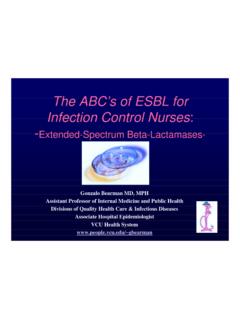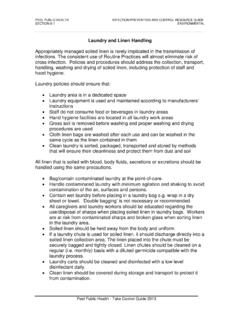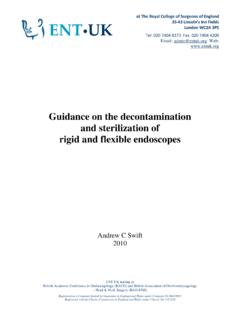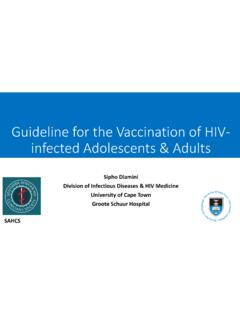Transcription of Evaluation of Diagnostic Serological Results in Cases of ...
1 ORIGINAL STUDY. Evaluation of Diagnostic Serological Results in Cases of Suspected Primary Syphilis Infection Beau Gratzer, MPP,* Daniel Pohl, BA/BS, and Anna L. Hotton, MPH, PhD* . history of syphilis, the US Centers for Disease Control and Background: Reverse sequence screening for syphilis, in which an auto- Prevention (CDC) recommends performing the Treponema matable treponemal assay (enzyme immunoassay [EIA]/chemiluminescence pallidumYpassive particle agglutination assay for confirmation of assay [CIA]) is performed first and followed by a nontreponemal test for ,4,5 Although it is no longer recommended by CDC, reactive specimens, has been used increasingly in the United States. The many public health and commercial laboratories continue to use EIA is objective, efficient, and believed to be more sensitive than the the fluorescent treponemal antibody absorption test [FTA-ABS].
2 Rapid plasma reagin (RPR) because treponemal antibodies appear as the secondary treponemal test to resolve discrepant Results . before nontreponemal antibodies. We sought to compare the sensitivity Reverse sequencing has become popular because EIA/. of a commonly used EIA, the Trep-Sure EIA (TS-EIA), to the RPR in CIA tests are automatable, thereby increasing throughput, and Cases of suspected primary syphilis infection in our clinic. are objectively read. Treponemal tests are reported to have su- Methods: A retrospective medical record review of patients with sexually perior sensitivity relative to nontreponemal tests in both early transmitted infection clinic visits from January 2009 to December 2011 and latent syphilis ,6Y11 Furthermore, nontreponemal was conducted, and 52 patients met the following inclusion criteria: tests suffer from high cross-reactivity with a range of other in- suspected primary syphilis symptoms, at least 1 positive syphilis test fections and conditions that may cause false-positive Results .
3 Result at visit, and no history of syphilis. Sensitivity analyses compared Controversy exists regarding the use of reverse sequencing, how- the TS-EIA and RPR, using the reference standard of concordantly ever, because of difficulty in clinical interpretation of discrepant positive/reactive TS-EIA/RPR or positive fluorescent treponemal anti- Serological Results and the abundance of presumed false-positive body absorption test (FTA-ABS) result. We considered equivocal TS-EIA treponemal tests that require substantial follow-up efforts of sur- Results to be positive for sensitivity calculations because such Results veillance and field ,5,12. typically reflex to additional testing and therefore may still result in iden- One of the most commonly used EIAs for reverse se- tifying new infections .
4 Quence screening is the Trep-Sure EIA (TS-EIA; Trinity Biotech, Results : Twenty-eight ( ) of the 52 patients had a positive or Jamestown, NY). The TS-EIA is a third-generation T. pallidum equivocal TS-EIA. Twenty-five ( ) of those were RPR reactive; total antibody sandwich assay that detects treponemal antibodies the remaining 3 ( ) were RPR nonreactive, FTA-ABS positive. to both immunoglobulins G and M using a proprietary recombi- Forty patients ( ) had a positive RPR, including 15 patients ( ) nant ,13 The TS-EIA produces qualitative Results via with negative TS-EIA Results ; all 15 were FTA-ABS positive. Nine ad- quantitative index values based on optical density (OD) signal to ditional patients were TS-EIA negative and RPR nonreactive but had a cutoff ratios.
5 An OD index value greater than is positive and positive FTA-ABS result. The RPR was significantly more sensitive less than is negative. Optical density index values between than the EIA ( vs. , P = ). Trep-Sure EIA positivity was and are equivocal and should trigger retesting and reflex also significantly associated with higher median RPR titer (P = ). to additional testing with other technologies; patients with con- Conclusions: Use of the TS-EIA may result in underdetection of pri- secutively equivocal Results and negative/nonreactive reflex test mary syphilis compared with the RPR. Further Evaluation of the sensi- Results are recommended to retest in 2 to 4 weeks because this tivity of the TS-EIA in high-morbidity settings is warranted before the may be an indication of recent syphilis ,11,13.
6 Adoption of reverse sequence screening algorithms. In December 2007, the Illinois Department of Public Health (IDPH) State Laboratory conducted a validation of the H igh-volume laboratories in the United States increasingly use a reverse sequence algorithm to screen for Reverse sequence algorithms use a treponemal test ( , en- TS-EIA in anticipation of transitioning to a reverse screening algorithm in early 2008. During the IDPH validation of the TS-EIA, a patient seeking testing at the STI Walk-in Clinic'' at zyme immunoassay [EIA] or chemiluminescence assay [CIA]) Howard Brown Health Center (HBHC) with no known history for initial screening and reflex to a nontreponemal test ( , of syphilis had an anomalous result: TS-EIA negative, RPR re- rapid plasma reagin [RPR]) for assessment of disease activity.
7 Active (titer 1:2), and FTA-ABS reactive. A second patient, also If an RPR is discrepantly negative in a patient without known with no known history of syphilis, presented for care in early 2008 with a penile lesion that had a reported duration of approx- From the *Howard Brown Health Center, Department of Research, Chicago, imately 1 month. The initial Serological result for the second IL; Ann & Robert H. Lurie Children's Hospital of Chicago, Center for patient was TS-EIA negative, RPR reactive (titer 1:8), and FTA- Gender, Sexuality and HIV Prevention, Chicago, IL; Division of Com- munity Health Sciences, School of Public Health, University of Illinois at ABS reactive. This patient underwent a punch biopsy on the le- Chicago, Chicago, IL; Howard Brown Health Center, Department of sion during a follow-up visit that was positive for treponemes.
8 A. HIV/STI Prevention, Chicago, IL; and John H. Stroger Hospital, portion of the original serum specimen was sent to the manufac- Division of Infectious Diseases, Chicago, IL turer for further Evaluation , and retesting also produced a negative Financial support: No nancial support was received for this study. TS-EIA result; the TS-EIA OD index value for this specimen Con icts of interest: None. was , which is well below the index value for an equivocal Correspondence: Beau Gratzer, MPP, Howard Brown Health Center, 4025. N Sheridan Rd, Chicago, IL 60613. E-mail: or positive result. The manufacturer performed 2 additional trep- Received for publication June 18, 2013, and accepted March 5, 2014. onemal tests, the Inno Lia and the Trep ID, and both produced DOI: positive Results .
9 This led the manufacturer to conclude that this Copyright * 2014 American Sexually Transmitted Diseases Association was likely a very early infection and that the TS-EIA was falsely All rights reserved. negative. Several additional discrepant Results were detected Sexually Transmitted Diseases & Volume 41, Number 5, May 2014 285. Copyright 2014 by the American Sexually Transmitted Diseases Association. Unauthorized reproduction of this article is prohibited. Gratzer et al. among suspected primary syphilis Cases at our facility throughout false negatives, using the reference standard described above the remainder of 2008. The medical staff of HBHC implemented as the basis for classifying syphilis infection. Exact confidence a protocol in January 2009 to request both RPR and FTA-ABS limits for sensitivity estimates were calculated based on the bino- testing for all STI Walk-in Clinic patients exhibiting symptoms sug- mial distribution.
10 Trep-Sure EIA and RPR sensitivity values gestive of primary syphilis when the TS-EIA result was negative. were compared using McNemar test for paired proportions. Sta- tistical analysis was performed using SAS version (SAS In- METHODS stitute, Cary, NC). We conducted a medical record audit of patients with suspected primary syphilis infection presenting at the HBHC Results . STI Walk-in Clinic between January 2009 and December 2011. Between January 2009 and December 2011, 72 patients Cases were included in the review if the patient had clinical signs at the HBHC Walk-in STI Clinic had clinical symptoms con- and symptoms suggestive of primary syphilis ( , chancre or sistent with primary syphilis combined with at least 1 positive/. genital/perianal/oropharyngeal ulcer of unknown etiology), at reactive Serological test result for syphilis.








